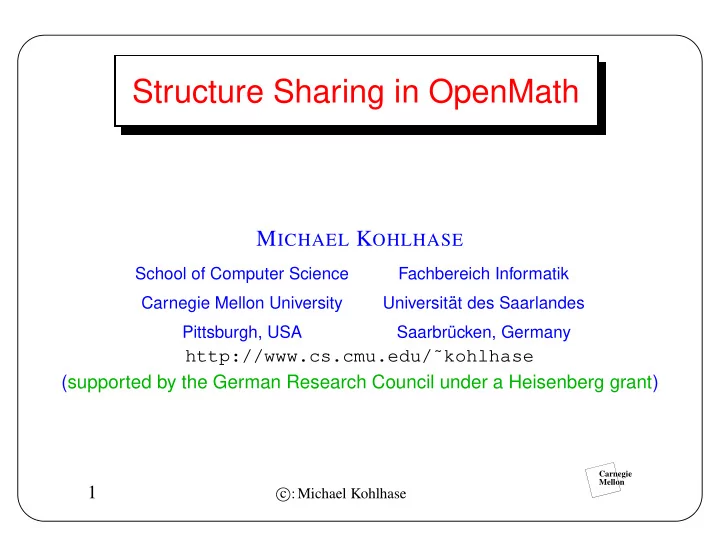

Structure Sharing in OpenMath M ICHAEL K OHLHASE School of Computer Science Fachbereich Informatik Carnegie Mellon University Universit¨ at des Saarlandes Pittsburgh, USA Saarbr¨ ucken, Germany http://www.cs.cmu.edu/˜kohlhase (supported by the German Research Council under a Heisenberg grant) Carnegie Mellon 1 � :Michael Kohlhase c
Wish: Cross-refening for O PEN M ATH objects • Status: OMDoc just went ahead (licensed by the O PEN M ATH standard) – new attributes id and xref for all O PEN M ATH objects that carry (not OMS, OMV, OMATP ) content – OMel with xref empty, xref points to element with same name – Semantics by copying. (simple transformation to standard O PEN M ATH ) • Advantages: sharing of (sub)-formulae (+space, +maintainance) • Problems: not based on X LINK yet, semantics differs from M ATH M L • Proposal: Extend OMel with (cleaned up version for O PEN M ATH ) – id attribute (for OM xref (sharing), M ATH M L xref (semantics)) – xref attribute (for OM sharing) Carnegie Mellon 2 � :Michael Kohlhase c
Structure Sharing with Directed Acyclic Graphs Tree DAG f f · f f f d f f f f f a a a a a a a a a · 2 d − 1 nodes d nodes Carnegie Mellon 3 � :Michael Kohlhase c
The same in the OpenMath XML encoding <OMOBJ> <OMOBJ> <OMA> <OMA> <OMV n="f"/> <OMV n="f"/> <OMA> <OMA id="t1"> <OMV n="f"/> <OMV n="f"/> <OMA> <OMA id="t11"> <OMV n="f"/> <OMV n="f"/> <OMV n="a"/><OMV n="a"/> <OMV n="a"/><OMV n="a"/> </OMA> </OMA> <OMA> <OMR xlink:href="t11"/> <OMV n="f"/> <OMV n="a"/><OMV n="a"/> </OMA> </OMA> </OMA> <OMA> <OMR xlink:href="t1"/> <OMV n="f"/> <OMA> <OMV n="f"/> <OMV n="a"/><OMV n="a"/> </OMA> <OMA> <OMV n="f"/> <OMV n="a"/><OMV n="a"/> </OMA> </OMA> </OMA> </OMA> </OMA> </OMOBJ> </OMOBJ> Carnegie Mellon 4 � :Michael Kohlhase c
Summary of the Proposal • Idea: Allow structure sharing in the XML encodeing by – straw-man element OMR (represents target of xlink:href attribute) – by id attributes on “fat” OpenMath elements (possible targets) • Pro: O PEN M ATH data model does not change (stays finite trees.) Both encodings encode the O PEN M ATH object application (f, application (f, application (f,a,a), application (f,a,a)), application (f, application (f,a,a), application (f,a,a))) • Problem: Acyclicity Constraint (general DG represent infinite trees) non-local condition to be verified for validity Carnegie Mellon 5 � :Michael Kohlhase c
Acyclicity Condition • Definition: We say that an – element dominates all its children and all elements they dominate. – An OMR element dominates its target, i.e. the element that carries the id attribute pointed to by the xref attribute. • acyclicity constraint: An element may not dominate itself! • Problem: Need to traverse the whole document tree to check. Carnegie Mellon 6 � :Michael Kohlhase c
Fun with Cyclic Graphs • Cyclic data structures can be useful, e.g. <OMOBJ> <OMA id="foo"> <OMS cd="arith1" name="divide"/> <OMI>1</OMI> 1 <OMA> <OMS cd="arith1" name="plus"/> <OMI>1</OMI> 1 <OMR xref="foo"/> 1 + </OMA> 1 1+ </OMA> 1+ ··· </OMOBJ> • and difficult <OMOBJ> <OMOBJ> <OMA id="bar"> <OMA id="baz"> <OMS cd="arith1" name="plus"/> <OMS cd="arith1" name="plus"/> <OMI>1</OMI> <OMI>1</OMI> <OMR xref="baz"/> <OMR xref="bar"/> </OMA> </OMA> </OMOBJ> </OMOBJ> Carnegie Mellon 7 � :Michael Kohlhase c
Changes to the DTD • add the declaration for the OMR element <!ELEMENT OMR EMPTY> <!ATTLIST OMR xlink:href CDATA #REQUIRED xlink:type CDATA #FIXED ’simple’ xlink:show CDATA #FIXED ’embed’> • add attribute list declarations <!ATTLIST OMA id ID #IMPLIED> for the elements OMA , OMBIND , OMATTR , OMI , OMB , OMSTR , OMF but not for elements – OMS , OMV , (to small, no need) – OME , OMBVAR , OMATP , (do not make sense on their own) – OMOBJ ( OMR can only be used inside OMOBJ ) • extend the entity declaration for %omel; , so that it reads <!ENTITY % omel "OMS | OMV | OMI | OMB | OMSTR| OMF | OMA | OMBIND | OME | OMATTR | OMR"> Carnegie Mellon 8 � :Michael Kohlhase c
A Synopsis of the Landscape of possible proposals Proposal DAGs in XML DAG data struct. CDGs Acyclic? yes/need check yes/need check no Reader? reader loops? reader loops? complex reader Pros same data model model � = encoding model � = encoding motivation save XML space allow common DS model complex DS Legacy? slightly extend reader slightly extend DS extend algorithms character conservative innovative radical Carnegie Mellon 9 � :Michael Kohlhase c
Recommend
More recommend